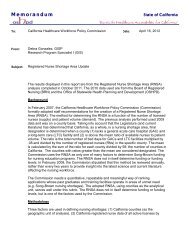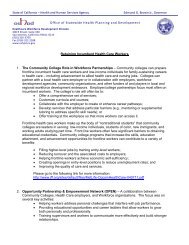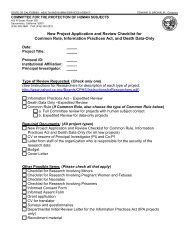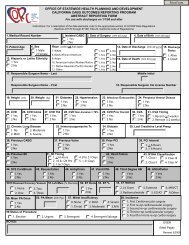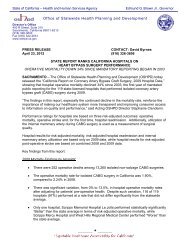Best Practices for Project Management, Design, and Construction of ...
Best Practices for Project Management, Design, and Construction of ...
Best Practices for Project Management, Design, and Construction of ...
You also want an ePaper? Increase the reach of your titles
YUMPU automatically turns print PDFs into web optimized ePapers that Google loves.
contingencies, that concur with defined scope. Value engineering should be addressed <strong>and</strong><br />
applied during the design development phase.<br />
<strong>Project</strong> Planning Phase<br />
<strong>Best</strong> Practice 3: Contact a Compliance Officer to determine whether or not a permit is<br />
needed <strong>for</strong> a remodeling project<br />
If a hospital owner is unsure whether a permit is needed, a hospital representative should check<br />
with the OSHPD Compliance Officer (CO). If a hospital owner proceeds without a permit to<br />
construct a project that requires one, it is considered unauthorized construction (sometimes<br />
referred to as a "bootlegged project"). Unauthorized construction can have serious ramifications,<br />
including noncompliance with licensing requirements, validation survey citations, <strong>and</strong><br />
noncompliance with Medicare Conditions <strong>of</strong> Participation <strong>and</strong> st<strong>and</strong>ards <strong>of</strong> accrediting<br />
organizations. Following a disaster, a damaged hospital that has unauthorized construction may<br />
not be eligible <strong>for</strong> Federal Emergency <strong>Management</strong> Agency (FEMA) assistance. Many OSHPD<br />
problems that arise with projects can at times be traced back to related unauthorized construction.<br />
OSHPD will require correction <strong>of</strong> all unauthorized construction <strong>and</strong> insist that the new work to be<br />
per<strong>for</strong>med under a building permit <strong>and</strong> designed to code.<br />
<strong>Best</strong> Practice 4: Assign project management duties to qualified people who can h<strong>and</strong>le the<br />
expected workload<br />
Obtaining a good outcome requires active management. Assignment is scalable; whereas<br />
installation <strong>of</strong> equipment may be managed by a single staff member, a hospital replacement<br />
project may require a team <strong>of</strong> managers. Remember, the design team, equipment vendors <strong>and</strong><br />
contractors may not have the same interests in the well-being <strong>of</strong> a hospital as that <strong>of</strong> its<br />
management team. <strong>Management</strong> control <strong>of</strong> the process is essential to minimize problems as the<br />
work proceeds through the OSHPD process.<br />
Assign a project manager to each project submitted to the FDD. The project manager is<br />
responsible <strong>for</strong> the overall coordination required to ensure a successful project. The project<br />
manager ensures that all players know their roles. FDD experiences indicate the following<br />
potential problems related to project management:<br />
• Some hospitals do not use project managers <strong>and</strong> expect all project participants (architect,<br />
engineers, IOR, contractor, etc.) to communicate <strong>and</strong> coordinate among themselves <strong>and</strong><br />
with OSHPD. This coordination <strong>and</strong> communication <strong>of</strong>ten does not occur without a project<br />
manager.<br />
• Some hospitals believe the IOR serves as the project manager. The IOR has a defined role<br />
<strong>and</strong> it does not include project management.<br />
(OSHPD <strong>Best</strong> <strong>Practices</strong>) Page 89 DRAFT FINAL, Sept. 2011



